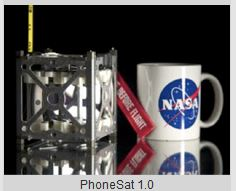I’m going to date myself by saying I’ve been a space aficionado since a young kid. I was fascinated by the Russians launched Sputnik 1. In fact, the NASA home page is one of my favorite bookmarks for looking not just at the cloud-propelled pictures coming from the new Mars rover Curiosity, but from keeping track of the latest innovations.
It is thus with no small measure of awe that I direct your attention to a recent item, innocuously titled, PhoneSate Flight Demonstrations. I’m sure it will amaze you as much as it did me.
A new type of convergence: smartphones and satellite construction
As stated in the posting, a small group of engineers working out of the agency’s Silicon Valley outpost at the Ames Research Center at Moffett Field, Calif., has been tasked with the mission to rapidly build inexpensive satellites (aka nanosatellites). The goal is to live by the Valley’s credo of “release early, release often.”
What they have come up with is astounding. In a display of true technology convergence, they employed mostly off-the-shelf smartphone technology to produce three prototype satellites and came in for each at under $3,500 per nanosatellite.
Since only a picture can do this real justice, below is one of the many photos in the posting. IT shows just how small these things are.

As NASA explains, the reason to use smartphone technology was one based on both practicality as well as adaptability. As they note: “Out of the box smartphones already offer a wealth of capabilities needed for satellite systems, including fast processors, versatile operating systems, multiple miniature sensors, high-resolution cameras, GPS receivers, and several radios.”
These babies weigh less than four pounds and come in a cube that measures roughly four inches. In other words, they could fit in a backpack rather easily.
Another advantage of using smartphone technology is that using commercial capabilities enables rapid design and alteration, making upgrades much faster as the customization of most components is no longer needed. This fits nicely with the objective of prototyping quickly and creating next-generation capabilities in very short periods of time.
NASA already has produced PhoneSat 1.0 and PhoneSate 2.0, and three systems (two PhoneSat 1.0's and one PhoneSat 2.0) are scheduled to launch aboard the maiden flight of Orbital Sciences Corporation's Antares rocket from NASA's Wallops Flight Facility at Wallops Island, Va., later this year.
What PhoneSats can do
PhoneSat 1.0, is built around the Nexus One smartphone made by HTC Corp., running Google's Android operating system. NASA says, “The Nexus One acts as the spacecraft onboard computer. Sensors determine the orientation of the spacecraft while the smartphone's camera can be used for Earth observations. Commercial-off-the-shelf parts include a watchdog circuit that monitors the systems and reboots the phone if it stops sending radio signals.”
It is designed to live in space for a short period of time, sending back digital imagery of Earth and space via its camera, while also sending back information about the satellite's health.PhoneSat 2.0 will equip a newer Nexus S smartphone made by Samsung to provide a faster core processor, avionics and gyroscopes. NASA says this next iteration adds a two-way S-band radio to allow engineers to command the satellite from Earth, solar panels to enable longer-duration missions, and a GPS receiver. In addition, PhoneSat 2.0 will add magnetorquer coils – electro-magnets that interact with Earth's magnetic field – and reaction wheels to actively control the satellite's orientation in space. What comes nextThe launch in 2013 will demonstrate the ability of the PhoneSate to perform sophisticated Heliophysics missions. Goals include:
- Qualifying new technologies and components for space flight
- Conducting low-cost Earth observations
- Exploring the moon and beyond
For those interested, the PhoneSat project is funded by NASA's Space Technology Program which is managed by the Office of the Chief Technologist. The program
“Develops and matures broadly applicable technology essential for scientific, robotic, and human exploration beyond low Earth orbit, ensures the agency’s technology portfolio contains both the near-term mission-driven and long-range transformative technology required to meet our nation’s exploration and science goals, and advances revolutionary concepts and capabilities, lowering development costs and reducing risk for NASA missions by engaging NASA Centers, small businesses, academia, industry, other Government agencies and international partners.”
With an eye on lower cost space exploration for a variety of purposes, and the ability to form significant public-private partnerships as space exploration becomes much more of a commercial exercise, the development of such low-cost, easily upgradeable satellites is a true feather in NASA’s cap as it redefines its own overall role and where it can create value.
This is an interesting example of where big science can come in small packages.
If you are like me, bookmarking the NASA site not only provides a great glimpse into the present, but also a wonderful vista into lies ahead. There is also a lesson to be learned here that should not be lost. You never know where next-generation value is going to come from, and technology transfers are vitally important to the innovation process.
The one caveat here is don’t try this at home since as of now smartphones can’t fly on their own unless you happen to have a spare rocket in your garage capable of putting small objects into earth orbit. Who knows, maybe that is what is next.
Edited by
Braden Becker